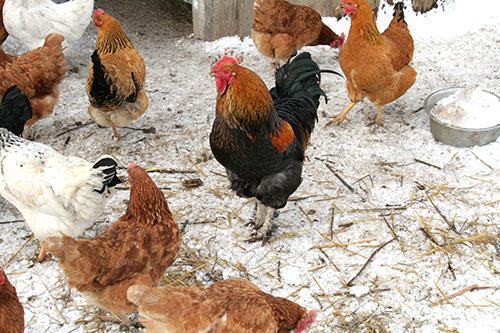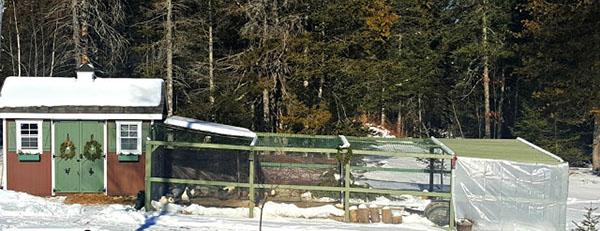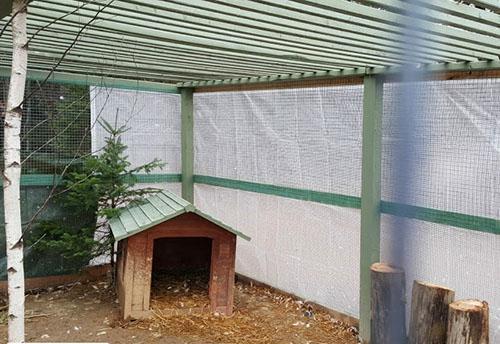How to insulate a chicken pen for the winter
 As winter approaches, it is very important to warm up your chicken coop: spread a thick layer of fresh straw, cover the windows with clear plastic, provide good ventilation in the room, place bales of straw along the inner walls for thermal insulation, and curtain the nesting areas to prevent eggs from freezing. However, it is equally important to prepare the chicken pen for winter.
As winter approaches, it is very important to warm up your chicken coop: spread a thick layer of fresh straw, cover the windows with clear plastic, provide good ventilation in the room, place bales of straw along the inner walls for thermal insulation, and curtain the nesting areas to prevent eggs from freezing. However, it is equally important to prepare the chicken pen for winter.

There are times when chickens have to be transported from a warm climatic zone to a colder one. However, they can experience a real shock. But if you do everything right and prepare the chicken coop and pen well for winter, the birds will feel great.
I want to share with you the secrets that will help create comfortable conditions for chickens in the hen house and pen in the cold season.
Wrapping the pen with clear plastic
 It is known that chickens are fairly hardy birds. But I noticed that strong winds are of particular concern to them. The protective plastic will block wind as well as prevent snow from entering. If you have a small paddock, you can wrap it completely (except for the top - you don't want your paddock to collapse under the weight of a snow cap!). If the pen is large, wrap it on only one side - preferably the one from which the wind blows more often.
It is known that chickens are fairly hardy birds. But I noticed that strong winds are of particular concern to them. The protective plastic will block wind as well as prevent snow from entering. If you have a small paddock, you can wrap it completely (except for the top - you don't want your paddock to collapse under the weight of a snow cap!). If the pen is large, wrap it on only one side - preferably the one from which the wind blows more often.
 Since my pen is quite spacious, I only wrapped it on the northeast side and in the corners. The result is a U-shaped wind protection. I also wrapped plastic around the side of the pen next to the exit of the chicken coop, which is covered with a solid roof. This creates an excellent protected area just a few steps from the chicken coop.
Since my pen is quite spacious, I only wrapped it on the northeast side and in the corners. The result is a U-shaped wind protection. I also wrapped plastic around the side of the pen next to the exit of the chicken coop, which is covered with a solid roof. This creates an excellent protected area just a few steps from the chicken coop.
You can also use plywood, pallets, tarpaulin, and even bales of hay or straw for wind protection, but I still prefer clear plastic.
It lets in the sun's rays well, so the chickens in the pen are light and fun. It also traps heat inside, creating a greenhouse effect. Use only very strong transparent plastic to wrap the pen, as thin plastic is likely to tear in strong gusts of wind.
 The advantage of the tarpaulin is the presence of eyelets. You can screw large hooks into the fence posts and use carabiners or large rings to secure the tarp to the sides of the pen, and when spring comes, simply remove it. In addition, in calm weather, you can roll up the tarp and fix it on the upper hooks, and with the onset of inclement weather, lower it down again.
The advantage of the tarpaulin is the presence of eyelets. You can screw large hooks into the fence posts and use carabiners or large rings to secure the tarp to the sides of the pen, and when spring comes, simply remove it. In addition, in calm weather, you can roll up the tarp and fix it on the upper hooks, and with the onset of inclement weather, lower it down again.
Canopy areas
 Since the top of your pen is likely open, provide sheltered areas for the chickens. A doghouse or just a small roof area is a great option. Chickens love to doze in the booth on a warm bed of straw during the daytime.
Since the top of your pen is likely open, provide sheltered areas for the chickens. A doghouse or just a small roof area is a great option. Chickens love to doze in the booth on a warm bed of straw during the daytime.
Thatched paths
 Chickens don't particularly like walking in the snow. The straw-lined paths will encourage them to move more around the paddock on sunny winter days, and also keep their paws from freezing during walks. When I scoop the old straw out of the chicken coop, I scatter it around the pen and form paths from it.
Chickens don't particularly like walking in the snow. The straw-lined paths will encourage them to move more around the paddock on sunny winter days, and also keep their paws from freezing during walks. When I scoop the old straw out of the chicken coop, I scatter it around the pen and form paths from it.
Stumps and logs in the paddock
 After the chickens leave the hen house and into the pen, they will appreciate the stumps, logs or just tree branches prepared for them - this way they do not have to stand with their paws on the cold ground.
After the chickens leave the hen house and into the pen, they will appreciate the stumps, logs or just tree branches prepared for them - this way they do not have to stand with their paws on the cold ground.
Leaning spruce branches against the enclosure fence will help the chickens use them not only as a roost, but also as a shelter with a canopy to hide from the gust of wind.
Dust baths
 On dark, cold winter days, chickens can get bored in the pen. By installing a dust bath, which is no longer available to them in the garden, you will keep the chickens busy, since this procedure is an excellent prevention of external parasites. You can use a rubber tub, paddling pool, or large plastic container.
On dark, cold winter days, chickens can get bored in the pen. By installing a dust bath, which is no longer available to them in the garden, you will keep the chickens busy, since this procedure is an excellent prevention of external parasites. You can use a rubber tub, paddling pool, or large plastic container.
Fill the tub with a mixture of sand, dry soil, and wood ash.
Then install it either in the chicken coop or in the pen if there is an area under a sturdy canopy.
A nutritious treat to lure birds out of a chicken coop
 So, your pen is protected from wind and snow with plastic or tarpaulin; paths are lined with straw; there are several logs on which the chickens are comfortable to sit; installed their favorite dust bath, and now there is only one thing - to lure the birds out of the chicken coop. Sunflower seeds or mealworms work best!
So, your pen is protected from wind and snow with plastic or tarpaulin; paths are lined with straw; there are several logs on which the chickens are comfortable to sit; installed their favorite dust bath, and now there is only one thing - to lure the birds out of the chicken coop. Sunflower seeds or mealworms work best!
I hope my simple tips will help your chickens spend more time outdoors in the pen during winter - this will not only have a beneficial effect on their health, but also help you keep the chicken coop clean for longer!
Warm beautiful chicken coop - video
